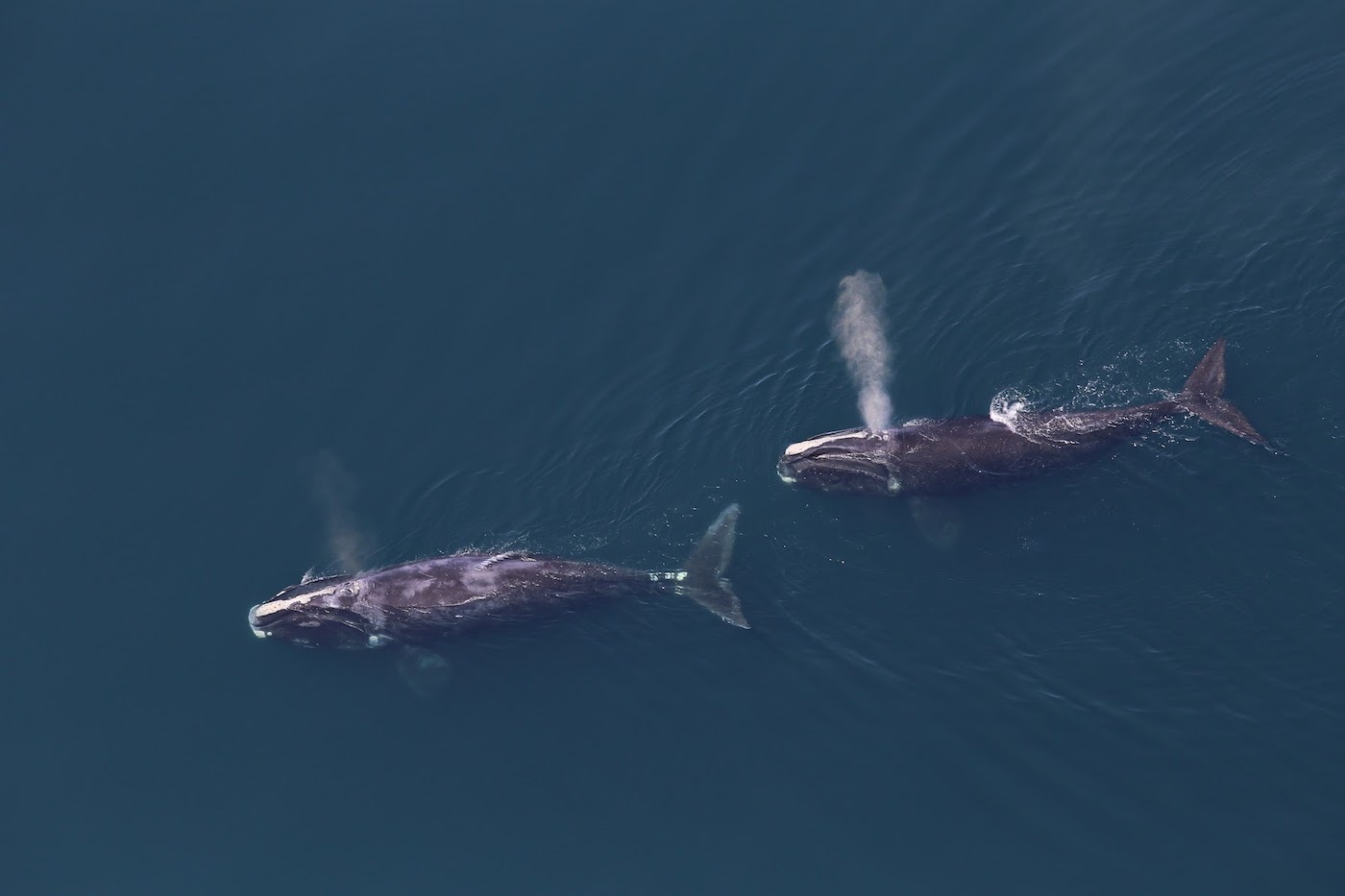
 This article is part of The State of Science, a series featuring science stories from public radio stations across the United States. This story, by Eve Zuckoff, was published in collaboration with WCAI.
This article is part of The State of Science, a series featuring science stories from public radio stations across the United States. This story, by Eve Zuckoff, was published in collaboration with WCAI.
By the time researchers found the dead whale on a Martha’s Vineyard beach, her jet-black skin was pockmarked by hungry seagulls, her baleen had been dislodged from her mouth, and thin rope was wrapped tightly—as it had been for 17 months—around the most narrow part of her tail.
Researchers quickly learned this was a 12-ton, 3-year-old female known as 5120, and that she was a North Atlantic right whale, a species with just about 360 members left.
A few weeks later, NOAA Fisheries announced that the entangling rope came from lobster fishing gear set in Maine state waters. The pain and discomfort of the entanglement likely affected 5120’s ability to swim and eat until finally, experts say, exhaustion or starvation probably killed her. A final cause of death is still pending.
The death of 5120 was devastating to right whale advocates, who know that losing a female doesn’t just mean losing one whale, but dozens of others that could have come from her future calves. For them, a death is often followed by a period of grief, and a renewed commitment to their work. And that might have been the end of 5120’s story.
But then came the online comments. Hundreds, perhaps thousands, across social media blamed offshore wind farms—the noise, electricity generated, and the mere presence of turbines. Along the way, the truth about 5120 became a non-concern.

In many cases, the rumors about offshore wind hurting and killing right whales are quite possibly spread from a place of concern, mistrust, or fear by well-meaning people who want to know our oceans are safe for marine mammals. But few people want that more than right whale scientists, who have dedicated their careers to saving a species that appears to be just a few decades from extinction. For many of them, talking about offshore wind has its own challenges, both because of the unknowns that come with a nascent industry and the knee-jerk reactions from people on all sides of the issue. So they say that yes, they’re uneasy about the potential threats of wind farms. But they agonize over the prospect of climate change destroying right whales’ shot at survival via their food web and ecosystem.
Threats To North Atlantic Right Whales
Some estimates suggest that, at their peak, 9,000-21,000 North Atlantic right whales swam just off the East Coast. But as the commercial whaling industry grew through the 18th and 19th centuries, the population floundered. In fact, their name came from whalers, who referred to them as the “right” whales to hunt because they were often found near shore, they swam slowly, and they tended to float after death, due to their high fat percentage. By the 1920s, perhaps fewer than 100 North Atlantic right whales remained.
But the population rebounded after commercial whaling was banned in 1935, and by 2010 there were as many as 483 individuals. Since then, however, that progress has been reversed.
Altogether, between 2011 and 2020, 43% of North Atlantic right whales died, and scientists say the species could become functionally extinct within the next 30 years.
Experts, backed by mortality data, say they now die almost exclusively from two causes. Over the last seven years, 39 right whales were seriously injured or killed by entanglements; lobster, snow crab, and jonah crab gear are primarily blamed.
Right whales are also often killed by vessel strikes, or run-ins with boats. Propellers can make deep cuts, or a collision can cause a blunt force trauma that leads to death. Because of their all-black coloring, proximity to shipping lanes, and tendency to spend long periods at the surface to feed and travel, they’re often just out of sight of boat captains, but not out of danger from the submerged hull or propeller.
Then came offshore wind.
A Pawn In A Fight Against Offshore Wind
In recent years, conservation groups that appeared to be grassroots organizations popped up across Massachusetts, Delaware, New Jersey, and elsewhere, to oppose offshore wind because of concerns about whales.
Reporters began finding links between the groups and fossil-fuel interests, but the scale of coordination wasn’t clear until a Brown University team began digging. In December 2023, researchers from the school’s climate and development lab released a paper that linked 18 of these groups—through funding, membership, legal representation, and more—to think tanks and conservative donors who are known to block climate policy in support of fossil-fuel interests.
“We found some evidence of a planning memo from 2012 that really laid out the game plan that they would use local groups that appear entirely local, but are being fed information from a centralized set of think tanks,” said Dr. Timmons Roberts, who led the report and studies disinformation around climate change at Brown University.
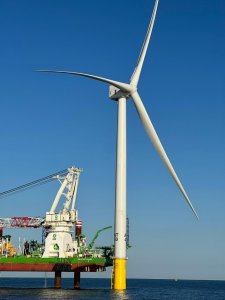
During his presidency, Donald Trump publicly made untrue claims about wind turbines causing cancer, killing birds, and making whales “a little batty.” In 2019, he also ordered more environmental reviews of Vineyard Wind, the first large-scale offshore wind project in the country—an expensive delay that some read as playing politics.
This is part of a larger pattern by some Republicans of using right whales to fight offshore wind. Simultaneously, politicians in the GOP have ignored or fought other efforts to protect whales against boat collisions and entanglements.
In the case of the right whale known as 5120, about five days passed between when Martha’s Vineyard residents found her carcass on a beach and when researchers revealed her preliminary cause of death to be chronic entanglement wounds. In that time, people started to speculate on social media and other platforms blaming Vineyard Wind’s project, which is under construction some 15 miles away from where the whale was found.
It appears a Martha’s Vineyard resident first claimed in a Facebook post that 5120’s injuries came from a thick rope researchers tied around her tail to move her off the beach for a post-mortem exam. It was widely cited thereafter.
Then, groups like one called Save the Dolphins and Whales New Jersey wrote on Facebook, “The whale did not have rope around its tail. It was only added afterwards.”
That post was shared hundreds of times, and soon similar false statements were showing up across Facebook, X, Instagram, and other online forums.
Meanwhile, some researchers working on 5120’s carcass checked social media in horror. They’d battled wind and waves in a storm to anchor 5120’s carcass when she first washed ashore. Then they spent hours standing inside the whale’s rib cage, tolerating the smell of her decaying flesh, and ultimately needed a power saw to get through the 4 to 5 inches of tissue that had grown over the rope to remove it from her tail.
A spokesperson for the International Fund for Animal Welfare (IFAW), which was in charge of the post-mortem operation, pointed to the tissue growth and said it is “simply not possible if lines are attached to an animal after it dies.”
A Changing Seascape Could Pose Threats To Wildlife
To build a wind farm, developers must bring massive infrastructure into the ocean. The turbines used by Vineyard Wind are expected to be 812 feet tall, including the blades—taller than Boston’s tallest skyscraper at 790 feet.
The sheer amount of work and steel it takes to build and operate an offshore wind farm has created four main categories of concern for right whale experts.
The first two build on existing threats: more boats in the water means there will be a higher risk of collisions with whales, and more equipment in the water increases the risk of entanglements in marine debris.
The third concern, about noise, has prompted some of the most intense online chatter.
There are worries that loud pile driving during construction could result in hearing impairment, or the sound could mask right whales’ vocal communication, or generally make them more stressed and affect behavior. Even so, early research has started to dispel some of these worries.
Dr. Doug Nowacek, who studies the link between acoustic and motor behavior in marine mammals at Duke University, studied several fin whales—a distant cousin of the right whale—near South Fork Wind, New York’s first commercial-scale offshore wind farm.
“We had tags on fin whales while pile driving was occurring, and we saw no dramatic responses,” he said. “A couple of the tagged whales did move south a few miles. But let’s keep in mind these are highly migratory, highly mobile species.”
He added that his team is still digging through data to see if there were any more subtle impacts that can be detected from the whales’ behavior.
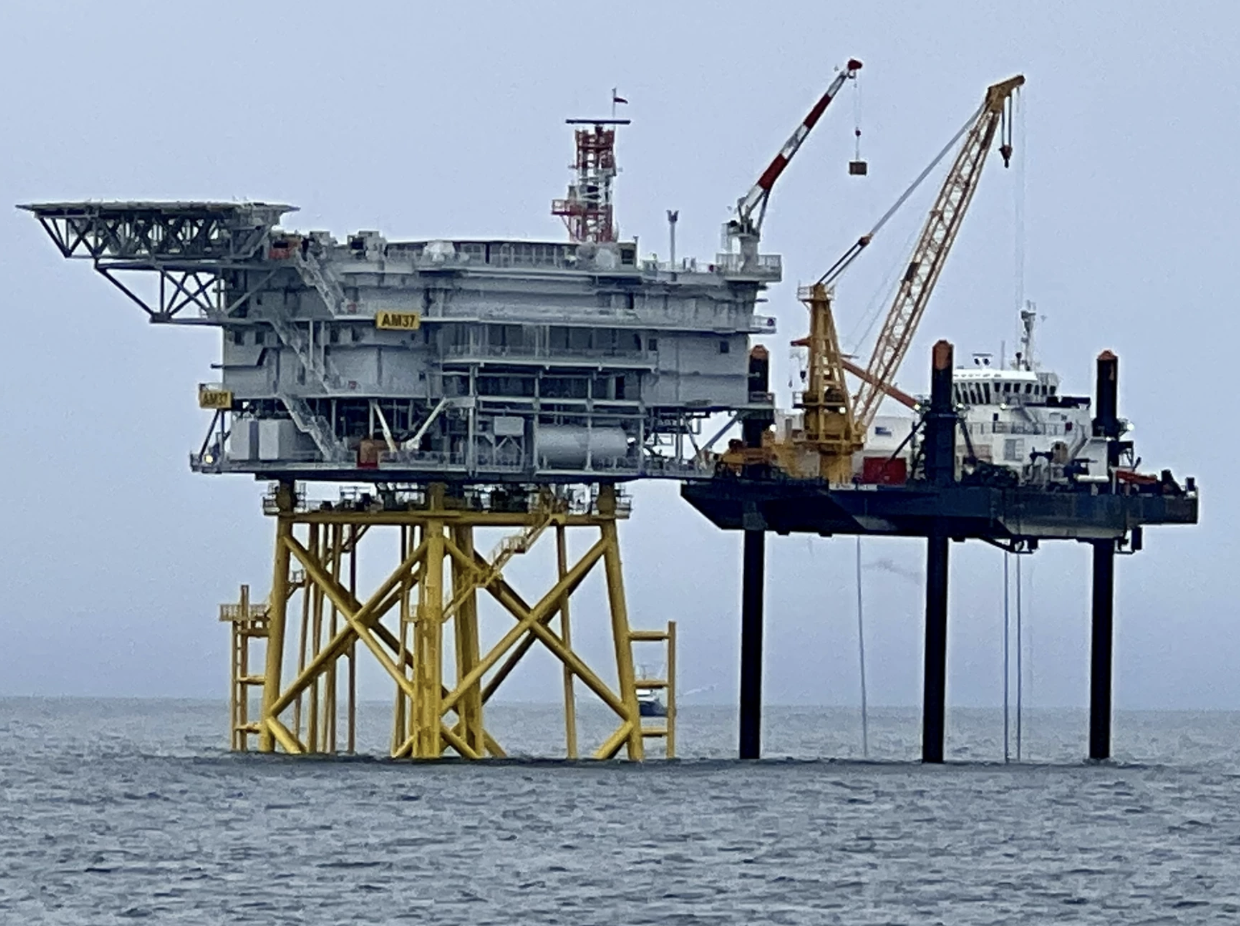
With regard to noise in the long term, experts like Nowacek say they believe risks are lower after construction is finished and the wind farms are operating because whales are deeply accustomed to most boat and ship noises. And bioacoustics experts from the University of Rhode Island found that the level of sound produced by the Block Island Wind Farm turbines is so low that just 50 meters away it can’t be detected above background noise unless there’s no wind blowing and no boat passing in the vicinity.
The last category of concern revolves around questions about whether wind farms could significantly change ocean circulation and affect the tiny copepods right whales like to eat.
Wind turbines extract wind energy out of the atmosphere, which means less energy moving and mixing the ocean. With less mixing, nutrients from deeper down may not reach the upper ocean where algae can grow.
“If you reduce the amount of nutrients to the algae, maybe there won’t be as many algae that are growing. If that’s the case, then maybe there aren’t enough algae to feed the copepods,” said Dr. Mark Baumgartner, a senior scientist at the Woods Hole Oceanographic Institution who studies how baleen whales approach their prey.
On the flip side, he said, as water flows past the turbines, eddies will form—swirling will happen—so the foundations could actually promote mixing, making patches of copepods more concentrated, which could mean better feeding opportunities.
Baumgartner said he probably won’t know whether offshore wind turbines create a net positive or net negative impact on copepods for years, which is one of the challenges of efforts to mitigate potential problems.
Feds Step Up Protections
NOAA Fisheries and the Bureau of Ocean Energy Management (BOEM) recently released a final strategy that identifies the agencies’ goals and key actions to mitigate the potential effects of offshore wind on North Atlantic right whales and their habitat. Some right whale advocates say they’re still waiting to see accompanying regulations to give the strategy teeth, but they were encouraged to see that it specifically says regulators should avoid leasing new wind developments in right whale habitat.
On noise, the strategy calls for maximum reductions and pushes developers to conduct underwater acoustic monitoring to listen for whales a full 24 hours in advance of loud foundation installation activities.
Many of the measures build on pledges developers have made with advocacy groups and ocean conservation organizations to protect right whales.
Vineyard Wind has agreed to boat-speed limits, a strict time frame for pile driving (it only happens when right whales’ main migration through the area is over), and the presence of marine observers, who search for right whales and stop construction if even one is in the area.
Meanwhile, the fishing industry has made efforts to reduce the threat of vessel strikes and entanglements, with mixed results.
Scientists Still ‘Uneasy’
Offshore wind isn’t a new industry. Thousands of turbines are up and running off Europe, but they offer little insight into potential effects on whales in the North Atlantic because there are few, if any, large baleen whales swimming off European shores near wind farms.
As a result, right whale scientists must stand by as offshore wind developers in the U.S. embark on a giant live experiment.
For right whales’ sake, Baumgartner and Nowacek agreed the best way to do that safely is to quickly collect as much data as possible. Already, they—like others—are working to determine best practices for the protection of whales, and also for dolphins, porpoises, and seabirds. Baumgartner said he hopes regulators will be able to learn and adjust offshore wind policy to protect marine life based on information gathered at 100 turbines, then repeat the process at 500 turbines, 1,000 turbines, and so on.
This approach may come with risks, but ultimately, many experts say it’s worth it. In fact, more than a half dozen scientists and right whale conservation advocates interviewed for this story said the biggest risk to right whales and other endangered species is the very danger offshore wind is designed to address: climate change.
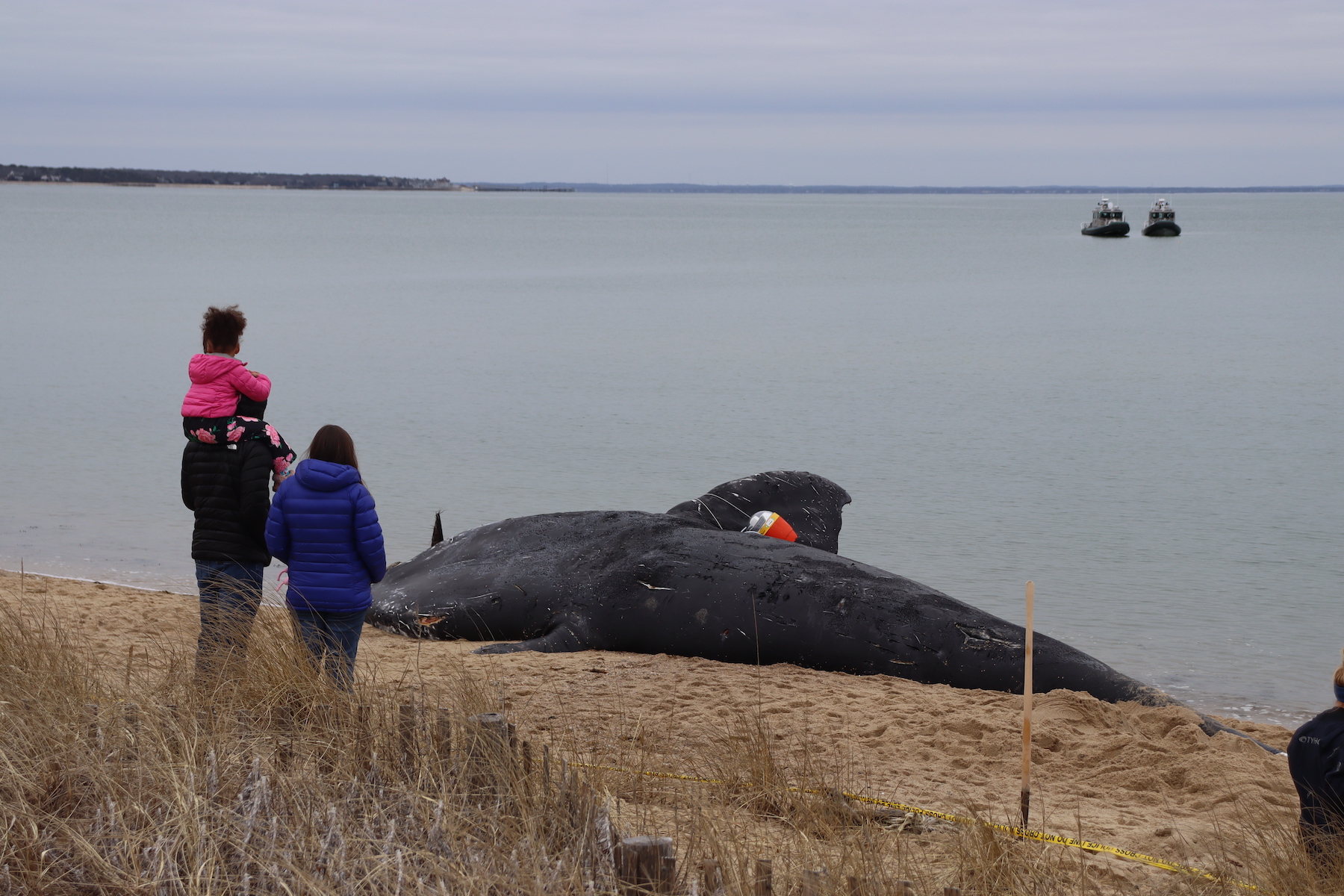
Dr. Stormy Mayo, a senior scientist and chair of the department of ecology at the Center for Coastal Studies in Provincetown, Massachusetts, said he feels torn. Mayo, whose youngest son works in the offshore wind industry, said he remains worried about impacts on whales he’s studied for more than 45 years, yet acknowledges offshore wind may well be the environment’s best bet.
“I’ve personally always felt very much concerned about the industrialization of the sea. And offshore wind is just another one of those cases,” he said. “But having watched these animals as long as I have … it is clear to me now that the biggest looming issue confronted by right whales is the impact of climate change on the sea.”
One disastrous example came in 2017. Scientists believe that, like most animals, right whales decide where to go by chasing their food. That year, warming temperatures caused copepods to shift north into waters with no boat-speed limits or fishing protections. Right whales followed, resulting in a catastrophic year where 35 North Atlantic right whales were found dead and not one new calf was detected.
The copepods could very well shift again as the impacts of climate change on the ocean intensify, sending right whales back into dangerous waters.
Offshore Wind And Climate Change
Currently, about 30 offshore wind projects are in various states of review in the U.S.
Vineyard Wind now sends energy from five of its 62 planned turbines into the grid—and South Fork Wind recently powered up its 12th and final turbine. Combined they’ll power about 470,000 homes. President Joe Biden has called for the equivalent of 10 million homes to be powered by offshore wind by 2030. It’s a key part of plans to drive down greenhouse gas emissions and mitigate climate change.
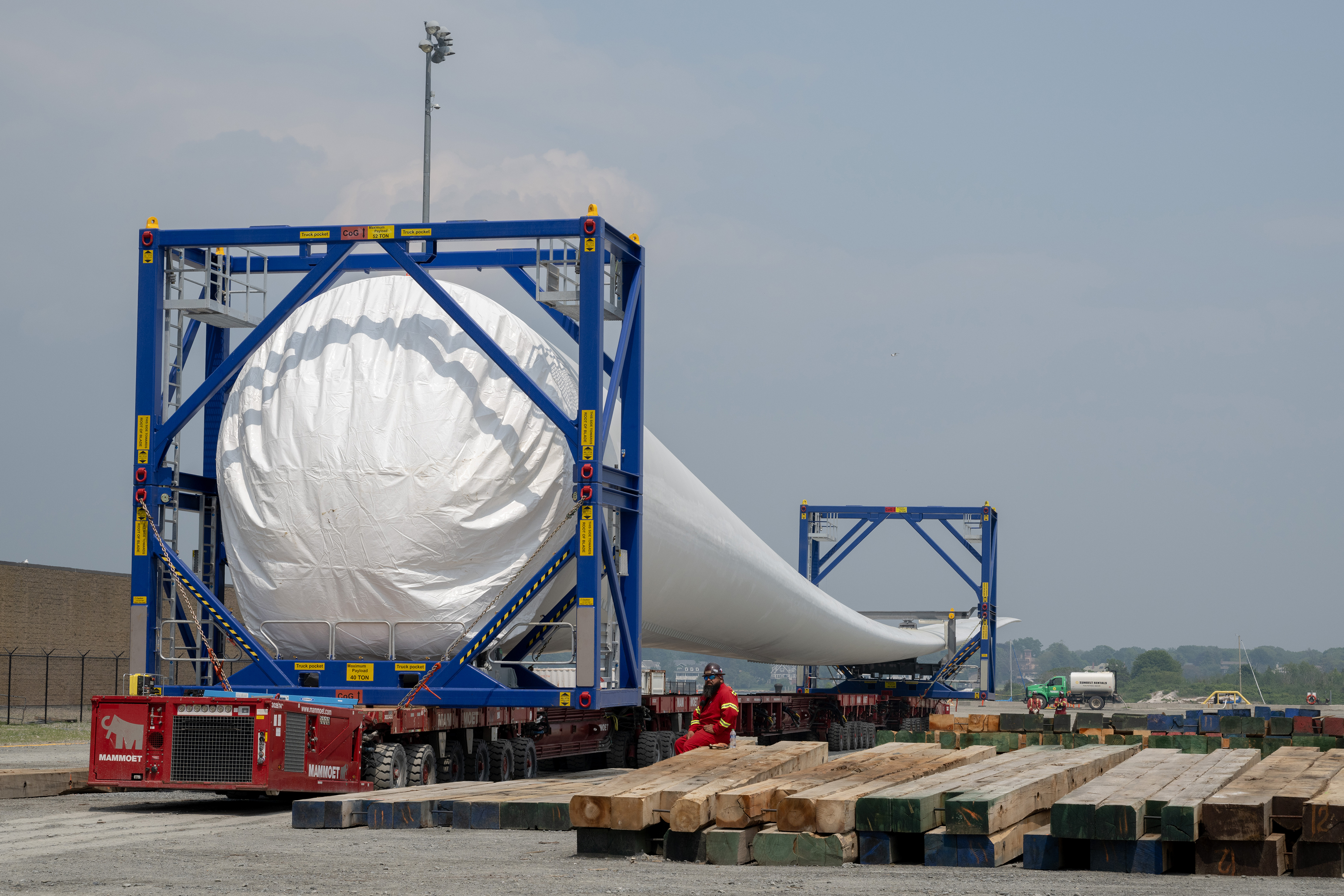
When a wind turbine is operating, it produces zero CO2 emissions, but there are emissions from its construction, maintenance, and ultimate decommissioning. Accounting for all emissions over the lifespan of a technology, the Department of Energy reports that offshore wind farms emit about 40 times less CO2 than natural gas to produce the same amount of energy, and about 90 times less than coal. One study found that the CO2 and energy expended over the lifespan of offshore wind turbines was “paid back” within the first 6 to 17 months.
And so far, the news for whales has been fairly good. Vineyard Wind began laying cable south of Martha’s Vineyard in November of 2022. The first turbine components started heading to the lease area, and major construction began in the fall of 2023. According to NOAA Fisheries, there hasn’t been any indication that a whale has been injured or killed by the project—or any other for that matter. South Fork, too, hasn’t been found liable for any whale deaths, despite claims made during a misinformation campaign in 2023.
“There are no known links between large whale deaths and ongoing offshore wind activities,” NOAA has reported.
5120’s Legacy
From the moment 5120 came ashore, the Martha’s Vineyard Aquinnah Wampanoag Tribe began a conversation about claiming her as one of their own.
“Our territory exists on this land, but our territory is also under what is now the ocean. And that’s how the chief has access, and has historical precedent, and has Indigenous, ancestral rights to creatures like this that come ashore,” said Jason Baird, the Tribe’s medicine man.
The Aquinnah Wampanoag Tribe, in collaboration with NOAA fisheries and IFAW, picked a wooded spot on their trust land to bless and bury 5120.
In about a year, Aquinnah Wampanoag citizens plan to use some of her bones for education and art. It’s given others who cared about 5120 in life and death a sense of peace.
“To know that she is resting on their land is just a really powerful thing,” said Dr. Sarah Sharp, an IFAW veterinarian.
While debates continue to rage about offshore wind and its possible effects on the world of whales, scientists remain focused on learning what they can. They hope those who are worried about the whales—5120 included—will put their energy where it can do the most good.
“All of the discussion about wind farms right now I feel like is just distracting from the real issues,” Sharp said. “We’ve got decades of data that these whales are dying from entanglements and vessel strikes. And we need to stay focused on those two main causes.”